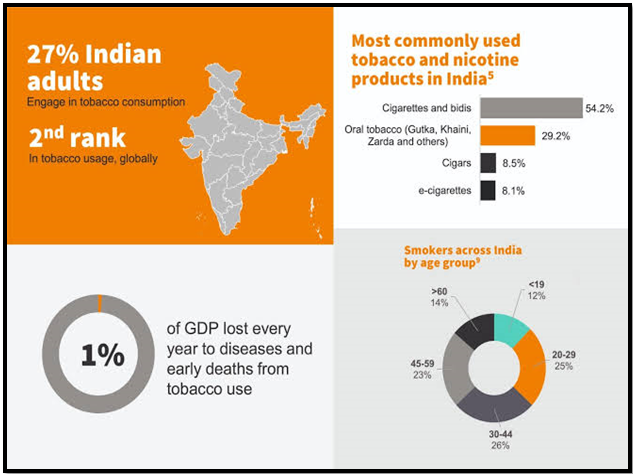ETHICAL CONCERNS IN IPL SURROGATE ADVERTISING FOR ORAL TOBACCO
Syllabus:
GS 2:
Government Policies and Interventions
- Issues Relating to Development and Management of Health.
Why in the News?
This article is in the news due to the ongoing debate about the ethical implications of surrogate advertising for oral tobacco products during high-visibility events like the IPL, highlighting concerns over public health and the role of media and celebrities in influencing consumption patterns.
Source: Edukida
Surrogate Advertisement and Ethical Concerns
- IPL’s Massive Reach: The IPL boasts a vast viewership, attracting advertisements from major firms and products with extensive reach and high sales.
- Prevalent Advertisements: Advertisements during IPL are dominated by gambling apps and “elaichi” and “masala” products, reflecting specific consumption patterns.
- Surrogate Advertising: Celebrities promote “elaichi” and “masala” pouches without disclaimers, indirectly advertising oral tobacco products.
- Ethical Question: While such surrogate advertising is legal, its ethical implications are questionable given its impact on public health.
- Misleading Marketing: The portrayal of these products as non-harmful and non-addictive misleads consumers about their true nature.
| Health Burden of Tobacco
Global Impact
Impact in India
Global Tobacco Control Initiatives
Tobacco Control Initiatives in India
|
Tobacco Consumption in India
- Focus on Oral Tobacco: Tobacco use in India is predominantly through smokeless forms, particularly oral tobacco, rather than smoking.
- High Prevalence: According to the Global Adult Tobacco Survey (GATS 2017), 29% of Indians over 15 consume tobacco, with 21% using oral tobacco and 10.7% smoking.
- Global Leader: India is a global leader in oral tobacco consumption, with prevalence rates exceeding 20%.
- Health Consequences: The high consumption rates correlate with high incidences of mouth cancer, which are increasing at a compound annual growth rate of 23%.
- Rising Use: The increase in mouth cancer cases parallels the rising use of pouched tobacco products.
Government Measures and Challenges
- Anti-Tobacco Legislation: The Indian government has implemented measures such as banning smoking in public spaces and increasing cigarette prices.
- Shift to Oral Tobacco: These measures have reduced smoking but led to an increase in oral tobacco use.
- Gutka Ban: Since 2011, most Indian states have banned the production and sale of gutka (masala mixed with tobacco), but enforcement remains challenging.
- Legal Challenges: The bans on gutka are often challenged in court, with occasional successes in overturning them.
- Limitations of Bans: Tobacco bans alone are insufficient due to the highly addictive nature of nicotine, making complete eradication difficult.
The Addictive Nature of Nicotine
- Nicotine Addiction: Nicotine, a highly addictive substance in tobacco, creates strong dependency, making cessation difficult.
- Consumer Awareness: Despite 92% of tobacco users being aware of its harmful effects, many struggle to quit due to addiction.
- Dependence Cycle: Regular consumption of tobacco leads to dependency, perpetuating the need for further use.
- Street Corner Sales: Retailers often sell masala or flavored mouth fresheners with low-priced or free oral tobacco (colloquially called “chhotu”), promoting addiction.
- Health Risks: Tobacco users are at high risk for numerous health issues, including heart disease, strokes, lung diseases, and various cancers.
Education and Prevention
- Importance of Education: The key to reducing tobacco use lies in educating people, particularly the youth, about the dangers of nicotine addiction.
- Modest Decline: There has been a slight decrease in tobacco consumption between the two GATS surveys (2010 and 2017), from 34.6% to 28.6%.
- Youth Trends: The decline in tobacco use is more pronounced among younger age groups (15-17 years) compared to older ones.
- Prevention Over Treatment: It is more effective to prevent young people from starting tobacco use than to help existing users quit.
- Contradictory Endorsements: Celebrity endorsements of masala products undermine educational efforts to prevent tobacco use.
Long-term Health and Social Impact
- Devastating Effects: Tobacco use devastates families and individual health, with 50% of users dying from tobacco-related illnesses.
- Life Expectancy: Tobacco can reduce lifespans by up to a decade, contributing significantly to premature death.
- Cancer Statistics: Tobacco-related cancers account for 42% of male and 18% of female cancer deaths in India for ages 30-69 years.
- Premature Death: Tobacco is the leading cause of premature death, emphasizing the need for effective prevention strategies.
- Role of Idols: Public figures should promote anti-tobacco messages to protect future generations from the long-term health threats posed by tobacco.
Way Forward
- Strengthen Regulations: Enforce stricter regulations on surrogate advertising to prevent misleading promotions of harmful products like oral tobacco.
- Public Awareness Campaigns: Launch comprehensive public awareness campaigns to educate citizens about the dangers of oral tobacco and nicotine addiction.
- Youth Education Programs: Implement educational programs in schools to inform young people about the health risks associated with tobacco use and the importance of making healthy choices.
- Support for Quitting: Provide better support and resources for individuals trying to quit tobacco, including access to cessation programs and nicotine replacement therapies.
- Celebrity Endorsement Ban: Prohibit celebrities from endorsing any products related to tobacco to prevent the glamorization of harmful substances.
- Community Engagement: Involve community leaders and local organizations in efforts to reduce tobacco use, making anti-tobacco messages more relatable and impactful.
- Research and Monitoring: Continuously monitor tobacco consumption trends and the effectiveness of anti-tobacco measures, adjusting strategies based on research and data to ensure long-term success in reducing tobacco use.
Conclusion
The ethical implications of surrogate advertising for oral tobacco during IPL highlight the need for stricter regulations and increased public awareness. While legal measures have had some impact, education and prevention remain crucial in combating nicotine addiction and reducing tobacco use in India. Public figures and idols play a vital role in promoting health-conscious behaviors and deterring young people from adopting harmful habits.
Source:The Hindu
Mains Practice Question:
Discuss the ethical and public health implications of surrogate advertising for tobacco products in India. How can regulatory and educational measures help mitigate the risks associated with tobacco consumption? Provide suggestions for effective policy interventions.




